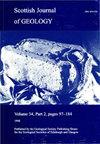阿伯丁郡迪河阶地最近考古调查的一些地貌学意义
IF 1.3
4区 地球科学
Q4 GEOLOGY
引用次数: 0
摘要
近年来,考古遗址的挖掘和调查为阿伯丁郡Banchory和Peterculter之间的Dee河阶地的年代提供了新的数据。首次根据海拔高度绘制了阶地碎片的地图并进行了关联。确定并命名了五个阶地表面,完善了英国地质调查局的术语(Merritt等人,2003)。其中三个是洛顿砂砾岩层内不同的表面。它们之间的关系,区域性冰川消融和克拉通以北的晚德文西公园湖的形成,表明它们的发展相隔了一段时间。在这些阶地下面,第四个阶地,坎普希尔阶地,通过发现旧石器时代晚期的燧石,可以追溯到温德米尔星际之前。Camphill Terrace被认为也是Younger Dryas内活跃的谷底。Camphill Terrace的切割时间尚不清楚:三个考古遗址的解释不同。最年轻的阶地填土和地表,Maryculter阶地,开始形成c。5000年前。本文章由计算机程序翻译,如有差异,请以英文原文为准。
Some geomorphological implications of recent archaeological investigations on river terraces of the River Dee, Aberdeenshire
Excavation and survey of archaeological sites have in recent years generated new data on the chronology of river terraces on the River Dee between Banchory and Peterculter in Aberdeenshire. Terrace fragments have been mapped and correlated on altitudinal grounds, for the first time. Five terrace surfaces are identified and named, refining the terminology of the British Geological Survey (Merritt
et al
. 2003). Three are distinct surfaces within the Lochton Sand and Gravel Formation. The relation between them, regional deglaciation and the formation of the Late Devensian Loch of Park, north of Crathes, suggests some time separated their development. Below these, a fourth terrace, the Camphill Terrace, is dated to before the Windermere Interstadial by finds of Late Upper Palaeolithic flints. The Camphill Terrace is argued to have been the active valley floor within the Younger Dryas also. Timing of incision from the Camphill Terrace is not understood: interpretations are different at three archaeological sites. The youngest terrace fill and surface, the Maryculter Terrace, began to form
c
. 5000 years ago.
求助全文
通过发布文献求助,成功后即可免费获取论文全文。
去求助
来源期刊

Scottish Journal of Geology
地学-地质学
CiteScore
1.70
自引率
0.00%
发文量
10
审稿时长
>12 weeks
期刊介绍:
Although published only since 1965, the Scottish Journal of Geology has a long pedigree. It is the joint publication of the Geological Society of Glasgow and the Edinburgh Geological Society, which prior to 1965 published separate Transactions: from 1860 in the case of Glasgow and 1863 for Edinburgh.
Traditionally, the Journal has acted as the focus for papers on all aspects of Scottish geology and its contiguous areas, including the surrounding seas. The publication policy has always been outward looking, with the Editors encouraging review papers and papers on broader aspects of the Earth sciences that cannot be discussed solely in terms of Scottish geology.
The diverse geology of Scotland continues to provide an important natural laboratory for the study of earth sciences; many seminal studies in geology have been carried out on Scottish rocks, and over the years the results of much of this work had been published in the Journal and its predecessors.
The Journal fully deserves its high reputation worldwide and intends to maintain its status in the front rank of publications in the Earth sciences.
 求助内容:
求助内容: 应助结果提醒方式:
应助结果提醒方式:


